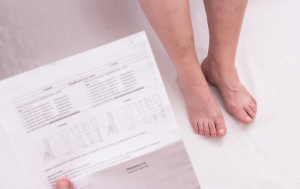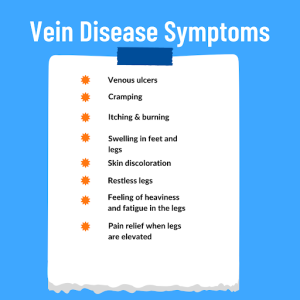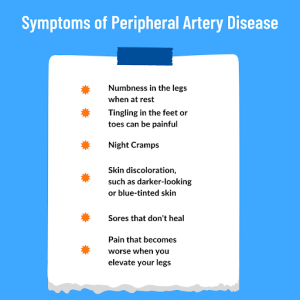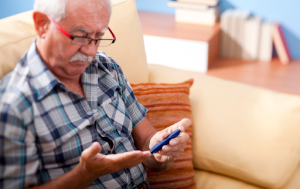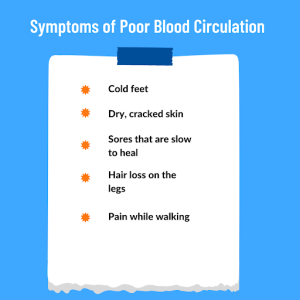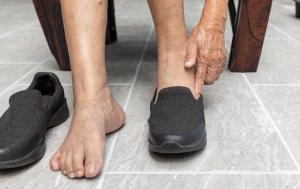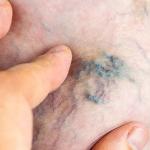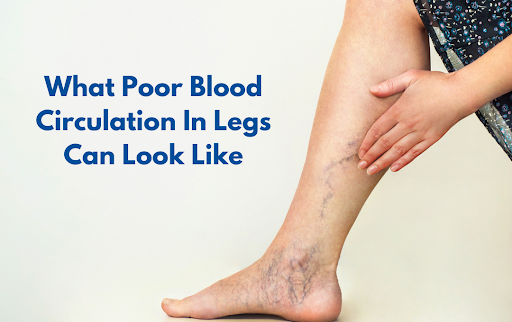
If you experience coldness, numbness, pain, or slow healing in your legs, it’s important to listen to your body. These symptoms could point to poor circulation, often caused by damaged veins or arteries. While various factors can affect circulation, vein health is crucial in leg circulation.
That’s why seeing a vein specialist is key. They can diagnose the root cause of your symptoms and recommend the right treatment to improve your circulation and overall health. Remember, untreated vein problems can increase your risk of blood clots and other serious conditions.
This guide looks at the possible causes of poor blood circulation in the legs and what you should do if you notice signs of circulation issues.
What Causes Poor Circulation in Legs?
The main causes of poor leg circulation are damaged leg veins, which is also the cause of vein disease.
Other health conditions leading to vein disease can also cause poor blood circulation. Lifestyle factors can play a role as well.
Let’s take a look at all of these potential causes of bad leg circulation and how they impact your vascular health.
1. Vein Disease
Vein disease, or chronic venous insufficiency, occurs when the valves in leg veins — the blood vessels that pump blood back to the heart — don’t work properly.
The valves don’t fully close when blood is pumped upward. As a result, blood pools, stretching the vein walls. This can lead to varicose veins, which are twisted, bulging veins in the legs. You also might have branch-like veins that appear beneath the skin’s surface, also known as spider veins.
This condition raises your risk of developing dangerous blood clots. If left untreated, it can worsen, leading to more severe symptoms.
Watch Our Webinar on Vein Disease Symptoms
2. Peripheral Artery Disease
Peripheral artery disease occurs when the arteries — the blood vessels that carry oxygenated blood from the heart to the legs and feet — become too narrow. Less blood flows to nerves and other tissues, leading to a feeling of fatigue, burning, or achiness in the muscles of the legs and feet.
Typically, people feel these symptoms when walking, climbing stairs, or exercising and find relief with rest.
Untreated PAD can lead to increasingly painful symptoms and increase your risk for a heart attack or stroke.
3. Diabetes
Diabetes can have a negative impact on the vascular system because high glucose levels can cause blood vessels to harden and narrow, decreasing blood flow.
High blood sugar levels, a hallmark of diabetes, can wreak havoc on your vascular system, the intricate network of blood vessels responsible for delivering vital oxygen and nutrients throughout your body. This damage, known as diabetic vascular complications, is one of the primary reasons why diabetes poses such a significant health threat.
Diabetes can trigger chronic inflammation in the body, further damaging blood vessels and contributing to poor circulation. Diabetes also can change how the blood clots, increasing the risk of blockages in blood vessels.
While diabetes is a significant risk factor for poor circulation, it is important to remember that other factors can also play a role, such as smoking, high blood pressure, high cholesterol, and obesity.
If you are concerned about poor circulation, it is vital to consult with a vein specialist for a proper diagnosis and treatment plan. They can perform tests to determine the underlying cause of your poor circulation and recommend appropriate treatment options. Early diagnosis and management of any underlying conditions can help prevent further complications.
SCHEDULE A VEIN CONSULTATION TODAY
If you have poor blood circulation in the legs from diabetes, you might notice symptoms that are similar to peripheral artery disease symptoms.
4. Being Overweight
Carrying extra weight on your body can put more pressure on your leg veins, damaging vein valves and leading to issues with varicose veins and bad leg circulation. Being overweight or obese is also associated with a higher risk of heart disease and other vascular issues, such as hardened arteries.
If weight gain contributes to poor circulation, you might notice more visible veins and the pain and discomfort caused by vein damage.
How Does Vein Treatment Improve Circulation?
How vein treatment improves circulation depends on the specific type of vein problem and the treatment used. Here’s a breakdown of common scenarios:
Varicose Veins:
- Treatment: Procedures like laser ablation, sclerotherapy, or phlebectomy target and eliminate varicose veins.
- Improvement: By removing these damaged and inefficient veins, blood flow is redirected to healthier veins, improving overall leg circulation. This can alleviate symptoms like swelling, aching, and cramping.
Spider Veins:
- Treatment: Similar to varicose veins, sclerotherapy or laser therapy are often used to close these smaller veins.
- Improvement: While spider veins themselves don’t significantly impact circulation, their removal can improve cosmetic appearance and address any associated discomfort.
Chronic Venous Insufficiency (CVI):
- Treatment: Depending on the severity, various options are available, including compression stockings, medication, and procedures like endovenous laser ablation or radiofrequency ablation.
- Improvement: By addressing the underlying issue causing CVI, such as damaged valves in veins, these treatments can restore proper blood flow direction and reduce venous pressure, alleviating symptoms like swelling, pain, and skin changes.
Wondering What’s Causing Your Circulation Problems?
If you have symptoms of vein disease and poor circulation, such as bulging veins, stiffness or swelling in the legs, and leg pain, schedule a consultation with a vein specialist near you.
Our doctors at USA Vein Clinics use advanced ultrasound technology to determine what’s causing your symptoms and provide an accurate diagnosis. They can then treat any damaged veins you have by rerouting blood flow to healthy veins, helping you experience better blood flow in your legs immediately.
Schedule a Consultation at USA Vein Clinics
Frequently Asked Questions About Poor Leg Circulation
How can I improve blood circulation in my legs?
There are many ways to improve blood circulation in your legs. Walking, stretching, and elevating your feet are three practices you can use immediately to support better circulation. Lowering your stress levels, quitting smoking, and working toward a healthier weight can also help in the long term.
Your doctor might recommend additional therapies to boost circulation, such as a leg circulation machine or compression stockings.
What foods can help boost circulation?
A diet rich in high-fiber foods and plenty of fruits and vegetables can support your heart and blood vessels. You can also add specific foods to your diet that are known to improve circulation, such as garlic, ginger, turmeric, beets, and berries.
Should I see a doctor for poor circulation?
If circulation issues in your legs are caused by vein disease, you’ll need to see a doctor to get rid of your varicose veins and treat damaged veins. Poor circulation isn’t reversible with home remedies like exercise and a healthy diet if you already have vein damage — but vein treatment can address your circulation issues and improve your vein health.
Sources:
Liu, Runyang et al. “The Impact of Diabetes on Vascular Disease: Progress from the Perspective of Epidemics and Treatments.” Journal of diabetes research vol. 2022 1531289. 8 Apr. 2022, doi:10.1155/2022/1531289
Medically Reviewed By:
Dr. Yan Katsnelson is a philanthropist, business owner, and highly skilled cardiac surgeon. He is the Founder and CEO of USA Vein Clinics, which is part of USA Clinics Group, the parent company of USA Fibroid Centers, USA Vascular Centers, and USA Oncology Centers, with more than 100 facilities nationwide. Dr. Yan has established himself as a strong advocate for accessibility and affordability of the most advanced medical care close to home. His mission is to create a positive experience for each patient with compassionate, personalized, and expert care.

